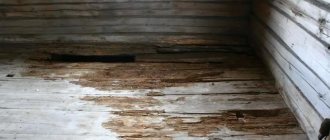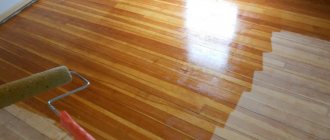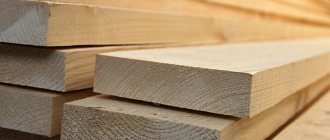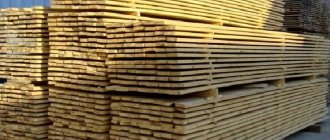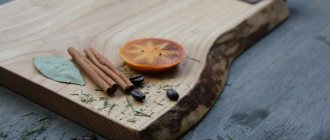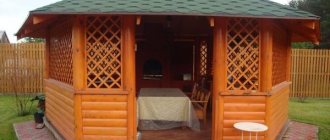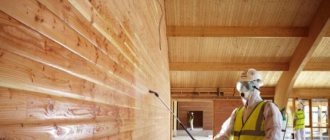A modern approach suggests planning beds from boards in combination with landscape design of the entire garden area. At the same time, it is important to know how to treat boards for beds in order to protect them from fungus and bacteria. This is necessary to get not only a neat, well-groomed appearance, but also an environmentally friendly harvest.
Boxes after processing before installation
Necessity of processing
Wood is considered an excellent material for wooden fencing for garden beds, as it has a number of positive characteristics:
- practicality in use;
- ease of assembly and installation;
- ergonomics in operation;
- environmental friendliness, which has a positive effect on plants, creating a favorable microclimate;
- the ability to accelerate the ripening process of garden crops;
- the possibility of growing on a suitable soil substrate, since the bed can be filled with any type of soil;
- ease of caring for plants;
- visual appeal of the garden bed.
But such designs also have disadvantages, which include:
- susceptibility to rotting and pest damage;
- dependence of properties on humidity, changes in physical and mechanical properties;
- the influence of atmospheric factors leading to swelling, shrinkage, warping and cracking.
Boxes before antiseptic
Therefore, to increase service life, there is a need to use special treatments with minimal damage to health. Measures to protect wood from damaging conditions must be taken during the construction of beds. Knowing what you can use to treat the boards, you can get original beds that will decorate your garden plot for a long time.
How to choose impregnation for boards
Having decided on what to cover the wooden beds with, you go to the garden center or online store to shop. Here you should approach your choice as responsibly as possible and purchase goods of the highest quality. Often the manufacturers themselves are disingenuous and indicate on the packaging that the product protects the boards from rotting in the soil, although in fact their effectiveness is quite low. You spend a lot of money and effort on creating high-quality beds from wood; if you initially saturate the wood with a bad product, you will soon have to spend money on boards and their installation again.
In order to immediately buy what you need, contact trusted stores, consult with professionals, use products from reliable manufacturers and check the originality of the product before using it. Such simple rules will protect you from fakes and allow you to achieve the desired result. Even if impregnation costs you a little more, it makes sense to overpay, because this will increase the service life of wooden beds many times over.
Folk remedies for treatment
A significant advantage of folk remedies over synthetic mixtures is the price, which is much lower.
In terms of ecology, these products are considered harmless and hypoallergenic, which is important for human health.
There are several effective ways to protect wooden buildings from rotting:
- A mixture of propolis and sunflower oil.
- Copper sulfate solution.
- Bitumen mastic.
- Heat treatment.
- Burning.
A mixture of propolis and sunflower oil
This product is made with your own hands. For preparation you will need oil and propolis in a ratio of 3:1. The components must be mixed and, taking a soft sponge, applied to a clean, dry surface of the material. It is important to saturate the wood well with the composition. The method is the most effective, as it perfectly protects the material from bacteria and fungus. When choosing it, you should also take into account the disadvantages: impregnated wood easily ignites.
Covering options for boxes
The most popular way to create board fencing is a box . Issues of vegetable growing using such structures are covered in many practical manuals from Russian and foreign authors. The bottom line is that the future planting area is fenced off from the rest of the site. The inner space of the box is filled with nutritious soil, thinking through an irrigation system and drainage, and a lawn is left outside or paths are laid.
In dacha farming, three options for installing structures are used: recessed, semi-recessed and raised. Accordingly, the methods of treating wood from rot and mold will be different.
For buried ridges , which have proven themselves well in arid southern regions, it is necessary to bury the entire sides into the ground, leaving only 5-15 cm above the surface. More often, such beds are made of metal or slate, but wood is also often used. To reduce the risk of rapid deterioration from constant humidity, the wood is pre-primed with ready-made antiseptic agents (oily or organic, preferably silicone-based), following the manufacturer's instructions, or thoroughly soaked in used machine oil and coated several times with copper sulfate .
When fully buried, the entire surface of the plank box is in direct contact with the soil
The workings are poured into a low, wide trough, the boards are laid in the liquid, trying to immerse them completely and leaving gaps. It takes at least 10-12 hours to thoroughly saturate the boards for beds with oil. Then the boards are dried in air and a box is assembled from them.
Copper sulfate is diluted at the rate of 100 grams per 10-liter bucket of water. Apply the finished solution with a brush in 2-3 steps, generously wetting all edges.
For semi-buried ridges, the lower part is processed similarly to the previous instructions, and the upper part can be coated with drying oil and painted . The prepared boards are first generously impregnated with drying oil, and after it dries, a layer of oil or nitra paint is applied. It is important to carefully paint all sections, leaving no room for moisture to penetrate.
At the finishing stage, instead of paint, if desired, use varnishes intended for outdoor use.
When creating high (raised) beds, it is important to protect the inside of the box from contact with wet soil, and it is desirable to give the outer surfaces an aesthetic appearance. Therefore, the board fencing is insulated on one side by mining or impregnated with copper sulfate, and on the other it is painted annually.
When choosing a paint coating, take into account the overall design style of the area
Finnish method
You can increase the resistance of wood to the harmful effects of moisture, pests and rot by using the Finnish method. You can make the composition yourself. To do this you need to take the following components:
- 1.6 kg of lime;
- 800 g flour;
- 400 g salt;
- 1.5 kg of vitriol;
- 10 liters of water.
Cooking method:
- Combine flour and cold water until a thick consistency is formed, then combine the resulting composition with the remaining ingredients.
- Heat the finished paste over low heat, mix well and cool slightly.
- Treat the surface of the wood with a warm solution.
- After absorption and complete drying, apply another layer. The degree of protection is regulated by the thickness of the applied layers, which ensures the suppression of all kinds of influences that can destroy the wood.
This treatment will protect the board for 15 years. But you need to take into account that when heated, copper sulfate releases dangerous substances. Therefore, it is advisable to use the designed beds exclusively for growing flowers. Otherwise, vegetables grown near wooden structures treated with this composition, when consumed by humans, can cause problems in the functioning of the digestive system.
Why is wood protection necessary?
The popularity of wood as an environmentally friendly material used in a variety of fields attracts both large manufacturers and ordinary users. But wood has one feature that is worth considering. It is weakly resistant to moisture and decay, therefore it is subjected to special treatment.
Before you start working with this natural material, you need to find out why wood needs protective manipulation by humans.
- Wood is a material that does not tolerate contact with moisture well. Most rocks begin to quickly become wet and deteriorate because of this, soon undergoing the process of rotting.
- Often wooden boards suffer from sudden temperature changes. They may begin to warp and become deformed.
- Wood can be seriously damaged by attacks from various wood parasites - beetles. They devour natural material, which is why its quality quickly decreases.
- Wood is also susceptible to fungal growths. The same mold, which often forms in conditions of high humidity, greatly spoils the quality and condition of the environmentally friendly material.
- The most dangerous thing for wood is contact with fire. The material not only ignites very easily, but also actively supports the flame.
To prevent all of the above factors from spoiling or completely destroying the natural material, specialized products are used that reliably protect the wood. After the treatment procedure, its performance characteristics and resistance to negative external influences increase sharply. The service life of wood increases noticeably, as does the service life of structures made from it.
People often neglect the use of protective compounds when constructing wooden structures. As a result, buildings quickly begin to lose their former attractiveness and reliability.
Softwood resins
You can treat the boards using coniferous resins, which are popularly called resin, as it prevents pathogens from penetrating the wood. Also, the natural substance is characterized by bactericidal and antiseptic properties. Time-tested method. Our ancestors treated wood with this miraculous substance.
The leading positions in popularity are occupied by cedar resin, pine, spruce, larch, and fir resin. But the downsides are the pungent odor and stickiness. You cannot apply varnish, paint, or sand the wood on top.
The ideal option would be to apply this composition to underground parts of structures.
Preparing the impregnation
Agrofabric
Agro-industrial fiber can be used not only for its intended purpose and to cover beds with it. It is well suited for protecting the bottom of wooden fences from moisture. The goal is to eliminate contact between the ground and the wood, allowing it to retain its structure. You can use two options. For example, spread along the perimeter under the fence, in places where the boundaries of the box pass.
Or spend a little more effort, but create more reliable protection. Wrap the lower part of the future sides of the ridge with fabric and attach it with a construction stapler. The pre-covering material is cut into strips. Their width should be such that when wrapped, the edges of the tape reach the middle of the board on both sides of the board.
Bitumen
The next way to preserve wooden beds is to cover them with bitumen mastic. It makes the wood moisture resistant, and this is one of the important properties of the future garden bed. Before starting work, the mastic is slightly heated and stirred until smooth. For more reliable protection, bitumen must be applied in at least three layers. It is advisable to first completely process all the details of the future ridge, and only then assemble them into a box. Please note that boards impregnated with this material are flammable.
Wax
Natural beeswax will create a reliable barrier against dampness. You definitely need real wax; you can buy it in stores that sell beekeeping products, or ask honey sellers at the market. Using wax in its pure form for large enough areas to cover is not a cheap pleasure. Therefore, we will focus on a more economical method and prepare oil and wax at home.
You will need wax and linseed oil; it is absorbed into wood better than others. We prepare the product based on a 1:4 ratio, in which the majority is an oil base. It must first be boiled and then poured into a glass container. Crumble wax there and place in a water bath. Gently stirring the mixture until the wax is completely dissolved. Treating the boards with this composition will perform a double function - it will oil the surface and create a waxy coating, enhancing the water-repellent properties of the wood many times over.
Siding
This option may be the most economical if repair work has recently been completed on your site and pieces of siding remain. It prevents the accumulation of capillary moisture inside the wood and adds strength to the structure. It is better to cladding on both sides, and secure the siding with self-tapping screws. To calculate the required amount of building material, the area to be covered is measured. Add 5% to the resulting figure. Such calculations will be needed when there is no leftover material at hand, and siding is purchased specifically for these purposes.
